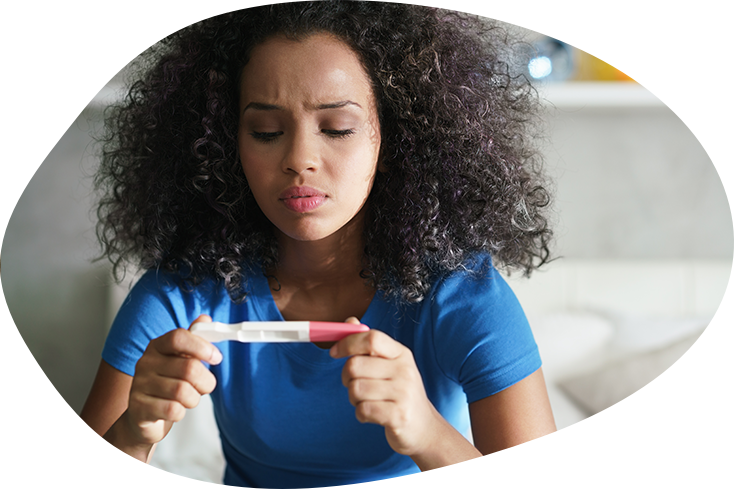What is Infertility?
Infertility can be caused by either female factors, male factors or a combination of both.
Infertility in Women
Female infertility can result from age, physical problems, hormone problems, and lifestyle or environmental factors.

There are a number of specific symptoms or conditions that can point to potential fertility issues in women, including the following:
- Irregular periods or amenorrhea (absence of menstruation) — This is often caused by excessive physical or emotional stress, extremely low or high body weight, or rapid weight loss or gain. All of these can affect production of the hormones needed for ovulation — follicle stimulating hormone (FSH) and luteinizing hormone (LH).
- Very painful periods
- Multiple abdominal surgeries
- Severe menstrual pain
- Endometriosis — A typically painful disorder in which tissue that normally grows inside the uterus grows outside the uterus, it can prevent implantation of a fertilized egg and is often an explanation for severe menstrual pain.
- Polycystic ovary syndrome (PCOS) — This is a hormonal disorder that causes enlarged ovaries with small cysts.
- Primary ovarian insufficiency — Also known as premature ovarian failure, it is often caused by an autoimmune response, genetics or chemotherapy.
- Blocked or damaged fallopian tubes
- Benign polyps or tumors such as fibroids

Learn more about fertility testing and diagnosis.
Infertility in Men
A number of issues can cause male infertility, including the following:
- Low sperm production
- Abnormal sperm function
- Blockages or obstructions that prevent the delivery of sperm to the ejaculate
These can be caused by illnesses, chronic health issues injuries or lifestyle factors.

Evaluating a Sperm Sample
In the laboratory, the sperm concentration is measured, and the sperm morphology and motility is examined. The specimen is also evaluated for infections or clumping. In addition, we can perform perform biochemical studies and other functional tests.
Sperm production is easily disturbed by colds, fever, infections, medications and environmental factors that may affect a man during the 3 months it takes for the entire sperm maturation cycle. Therefore, a single sperm analysis should not be relied upon, and we recommend performing 2 semen exams during each of 2 consecutive sperm generation cycles.
Systemic Evaluation and Treatment
Detected abnormalities usually need specific treatments that are often successful. Unspecific treatments such as hormone treatment of normal men, vitamins, antioxidants, and other nutrients have not achieved clinically proven results. Hormone stimulated cycles combined with intrauterine/intratubal insemination (IUI) have been shown to improve pregnancy rates in male infertility.
The development of in vitro fertilization with intracellular sperm injection (IVF – ICSI) has revolutionized the treatment of male infertility. Extremely low sperm counts and most types of sperm abnormalities can now be addressed with the IVF-ICSI procedure, and pregnancy rates are similar to treatment of female infertility.
Understanding Sperm Abnormalities
Oligozoospermia
Known as low sperm count, oligozoospermia is defined as a sperm count of less than 20 million per milliliter.
- It is frequently associated with poor sperm motility (movement) and an increased amount of abnormal sperm shapes.
- Pregnancies can still occur.
- A critically low sperm concentration below which pregnancies do not occur has not been established except for when no sperm are present in the ejaculate.
- Lower sperm numbers give lower pregnancy success.
When no sperm are present in the ejaculate, azoospermia exists.
- Azoospermia can be divided into obstructive azoospermia (OA) — where the efferent sperm ducts are blocked or congenitally abnormal — and non-obstructive azoospermia (NOA) — where internal testicular abnormalities affect sperm production.
- There is also a pre-testicular azoospermia caused by conditions affecting the hypothalamus and pituitary that send signals to the testis for sperm production. This is usually treated with hormones.
- For OA, surgical extraction of sperm from the ductal system or testis tissue is the treatment of choice.
- NOA is a more complicated condition to treat. Microsurgical sperm retrieval from the testis can be tried, but sperm are recovered in less than 50% of the attempts.

When to See a Fertility Specialist
If women have any concerns about their menstrual cycle, severe cramps, breakthrough bleeding, heavy bleeding, acne or abnormal hair growth, addressing these issues with a physician as soon as possible can help identify and address any issues or conditions that could impact your fertility.
In addition, you should see a fertility specialist in the following two situations:
- If you are under age 35, have normal periods and have unsuccessfully tried for 12 months to get pregnant
- If you are 35 or older and have tried unsuccessfully to conceive for 6 months or have experienced a miscarriage